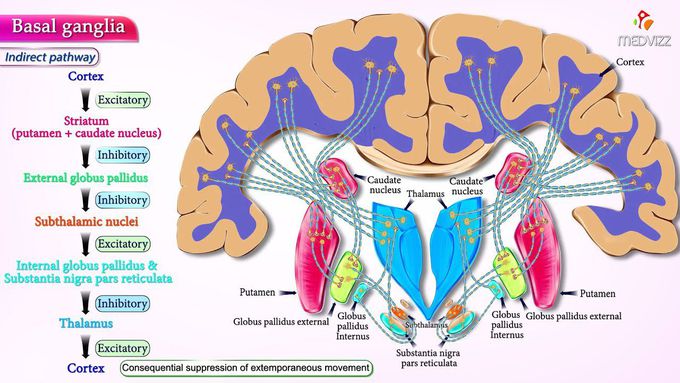


Basal ganglia Direct and indirect pathways - Neuroanatomy Animations
Follow On Instagram:- https://www.instagram.com/drgbhanuprakash Memberships: https://www.youtube.com/channel/UCG5TBPANNSiKf1Dp-R5Dibg/join Basal ganglia Direct and indirect pathways - Neuroanatomy Animations Basal ganglia ---------------------- The basal ganglia or basal nuclei are large masses of grey matter located within the central core of the white matter of the cerebral hemispheres. The basal ganglia are composed of the following grey nuclei: Caudate nucleus Lentiform nucleus Amygdaloid nuclear complex (or Amygdala) Claustrum Substantia nigra (within the midbrain) Subthalamic nucleus The lentiform nucleus is composed of two groups of neuronal soma (grey matter) known as the putamen and globus pallidus. The lentiform and caudate nuclei together constitute a mass of grey matter, the corpus striatum. Therefore, the basal ganglia can also be defined as a large mass of grey matter composed of the corpus striatum, amygdala, and claustrum, which is situated deep within the white matter of the cerebral hemispheres. Note that the substantia nigra and the subthalamic nucleus are not included in the above definition because they are usually described by several authors as only having a functional relationship with the basal ganglia. Direct pathway of the basal ganglia (excitatory) ---------------------------------------------------------------------------- Function: increase in motor activity Pathway: motor cortex → glutamate release → stimulates striatum → GABA release → inhibits globus pallidus internus (GPi), which usually inhibits thalamus → disinhibition of thalamus → stimulates premotor cortex → activates muscles → ↑ movement Additionally, the subthalamic nucleus stimulates substantia nigra → dopamine release → stimulates D1 receptor in striatum (further inhibits internal globus pallidus) Indirect pathway of the basal ganglia (inhibitory) ------------------------------------------------------------------------------ Function: decrease in motor activity Pathway: motor cortex → glutamate release → stimulates striatum → GABA release → inhibition of globus pallidus externus (GPe) → less inhibition of subthalamic nucleus → stimulates substantia nigra and globus pallidus internus (GPi) → inhibition of thalamus → inhibition of premotor cortex → deactivates muscles → ↓ movement substantia nigra → dopamine release → stimulates D2 receptor in striatum → inhibits GABA release → disinhibition of globus pallidus externus (GPe) → GABA release → inhibition of subthalamic nucleus → decreases stimulation of GPi → disinhibition of thalamus → ↑ movement Functions ---------------- There are a growing number of studies focused on the functions of the basal ganglia, as its functions are yet to be fully understood. However, the following are established functions involving the basal nuclei: a.Planning and modulation of movement pathways b.The basal nuclei is involved in the control of movement and learning c.Coordinating motivation with body movement. Specifically, the basal ganglia inhibits individual behavior in a complex social interaction and also inhibits small voluntary movement #basalganglia #directpathwayofbasalganglia #indirectpathwayofbasalganglia #directandindirectpathwayofbasalganglia #neuroanatomy #anatomyanimations #animatedanatomy #neuroanatomyanimations #usmleanatomy #basalgangliaanatomy

